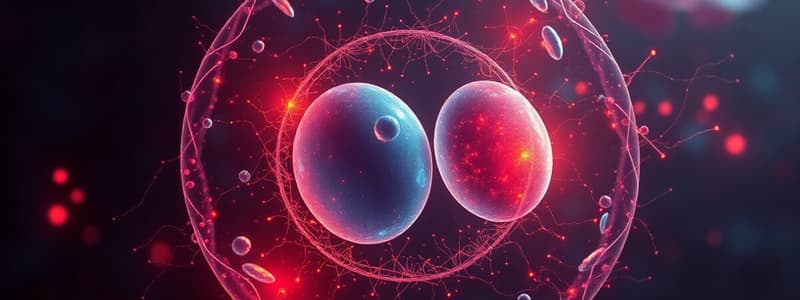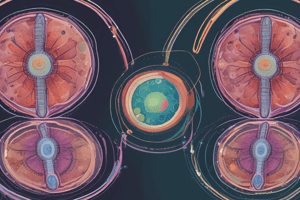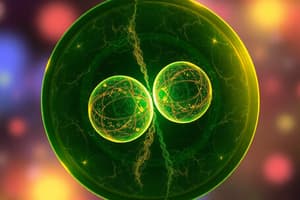Podcast
Questions and Answers
What is the primary outcome of mitosis?
What is the primary outcome of mitosis?
- Two genetically unique daughter cells
- Four genetically unique daughter cells
- Four genetically identical daughter cells
- Two genetically identical daughter cells (correct)
During which phase of mitosis do chromosomes align at the metaphase plate?
During which phase of mitosis do chromosomes align at the metaphase plate?
- Metaphase (correct)
- Prophase
- Telophase
- Anaphase
What is a key characteristic of meiosis?
What is a key characteristic of meiosis?
- It occurs only in somatic cells
- It results in identical gametes
- It produces two haploid cells
- It produces four genetically unique daughter cells (correct)
Which phase of the cell cycle involves DNA replication?
Which phase of the cell cycle involves DNA replication?
What is the role of checkpoints in the cell cycle?
What is the role of checkpoints in the cell cycle?
Which process directly follows mitosis?
Which process directly follows mitosis?
Crossing over occurs during which phase of meiosis?
Crossing over occurs during which phase of meiosis?
What is the consequence of mutations in cell division regulatory mechanisms?
What is the consequence of mutations in cell division regulatory mechanisms?
Flashcards
Cell Division
Cell Division
The process of a cell splitting into two or more daughter cells.
Mitosis
Mitosis
Cell division for growth and repair, producing identical daughter cells.
Meiosis
Meiosis
Cell division for sexual reproduction, creating unique daughter cells with half the chromosomes.
Cell Cycle
Cell Cycle
Signup and view all the flashcards
Mitosis Phases
Mitosis Phases
Signup and view all the flashcards
Crossing Over
Crossing Over
Signup and view all the flashcards
Gametes
Gametes
Signup and view all the flashcards
Cell Division Regulation
Cell Division Regulation
Signup and view all the flashcards
Study Notes
Introduction to Cell Division
- Cell division is the process by which a single cell divides into two or more daughter cells.
- It's essential for growth, development, repair, and reproduction in all living organisms.
- Two main types of cell division: mitosis and meiosis.
Mitosis
- A type of cell division that produces two genetically identical daughter cells from a single parent cell.
- Crucial for growth and repair in multicellular organisms.
- Occurs in somatic cells (non-reproductive cells).
- Four main phases: prophase, metaphase, anaphase, and telophase.
- Prophase: Chromosomes condense and become visible, nuclear envelope breaks down, spindle fibers form.
- Metaphase: Chromosomes align at the cell's equator (metaphase plate).
- Anaphase: Sister chromatids separate and move to opposite poles of the cell.
- Telophase: Chromosomes decondense, nuclear envelopes reform around each set of chromosomes, spindle fibers disassemble.
- Cytokinesis follows mitosis, dividing the cytoplasm and forming two separate daughter cells.
Meiosis
- A type of cell division that produces four genetically unique daughter cells from a single parent cell.
- Crucial for sexual reproduction.
- Occurs in germ cells (reproductive cells).
- Two rounds of division: Meiosis I and Meiosis II.
- Meiosis I: Homologous chromosomes separate. Prophase I features crossing over (genetic recombination).
- Meiosis II: Sister chromatids separate, similar to mitosis.
- Results in gametes (sperm and eggs) with half the number of chromosomes as the parent cell (haploid).
Cell Cycle
- A series of events that occur in a cell leading to its division into two daughter cells.
- The cycle involves interphase (where the cell grows and replicates its DNA) and the mitotic phase (where mitosis and cytokinesis occur).
Importance of Cell Division Regulation
- Tightly regulated processes to prevent uncontrolled cell division and ensure accurate DNA replication.
- Checkpoints in the cell cycle monitor DNA damage and ensure proper chromosome segregation.
- Mutations in these regulatory mechanisms can lead to cancer.
Differences between Mitosis and Meiosis
| Feature | Mitosis | Meiosis |
|---|---|---|
| Cell type | Somatic cells | Germ cells |
| Number of divisions | One | Two |
| Genetic outcome | Two genetically identical daughter cells | Four genetically unique daughter cells |
| Chromosome # change | No change in chromosome number | Chromosome number halved (haploid) |
| Purpose | Growth, repair | Sexual reproduction |
Studying That Suits You
Use AI to generate personalized quizzes and flashcards to suit your learning preferences.





